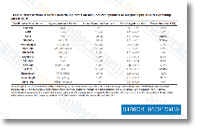From the DPPH scavenging assay, leaf extracts of L. indica were investigated by the free radical scaven ging activity via their reaction using the secure DPPH radicals. The radical scavenging activity values from the extracts are shown in Table two. Minimal EC50 value indi cates powerful skill of the extract to act as DPPH scaven ger. A higher EC50 value indicates lower scavenging exercise of your scavengers as extra quantities with the scavengers had been expected to attain 50% scavenging response. This implies, the scavengers are significantly less helpful in scavenging the DPPH radicals. Between the 4 extracts, the fractio nated water extract showed the stron gest scavenging activity in contrast using the standard ascorbic acid, followed by ethanol and ethyl acetate extracts.
The hexane ex tract showed the weakest scavenging exercise on DPPH radicals together with the EC50 value of 1285 ug ml. The existing consequence is consistent using the past information reported by Saha et al, which selleckchem C59 wnt inhibitor showed that methanol extract from your complete plant of L. indica also showed solid free of charge rad ical scavenging action comparable with quercetin, BHT and Vitamin C. The outcomes in Table one and Table two present that there’s a good correlation involving increased complete phenolic con tent within the extracts and stronger DPPH scavenging activ ity. This conclusion is supported by published reviews which indicated that phenolic substances frequently effectively correlated with scavenging activity on DPPH radicals. Hence, the robust DPPH scavenging exercise of fractionated water extract may be attributed from the high material of phenolic compounds, al however other antioxidants may well current inside the fractio nated water extract as well.
Decreasing energy of L. indica leaf extracts Preceding research have pointed out that the selleck chemicals Cilengitide antioxidant capability is usually associated towards the improvement of reduc tones which could terminate the no cost radical chain reac tions. The reducing energy of L. indica extracts are proven in Table three. In the decreasing power assay, a stronger absorbance signifies a increased minimizing energy. The extracts that showed comparable absorbance read ings with the constructive reference standard are regarded as to possess higher reducing power. The minimizing electrical power from the four extracts varied signifi cantly at unique concentrations. The decreasing energy of all of the extracts enhanced grad ually with the enhance in concentrations of the extracts.
Usually, the fractionated water extract showed a sig nificantly higher lowering power in any respect the tested concentrations in contrast on the other  extracts. This was followed by ethanol and ethyl acetate extracts, even though the hexane extract showed the lowest minimizing power amongst each of the examined concentrations.At concentration 0. eight mg ml, the reducing power of fractio nated water extract was comparable to that of ascorbic acid.
extracts. This was followed by ethanol and ethyl acetate extracts, even though the hexane extract showed the lowest minimizing power amongst each of the examined concentrations.At concentration 0. eight mg ml, the reducing power of fractio nated water extract was comparable to that of ascorbic acid.
Deubiquitinase
Mechanism, specificity and structure of the deubiquitinases
